The Google Nexus 9 Review
by Joshua Ho & Ryan Smith on February 4, 2015 8:00 AM EST- Posted in
- Tablets
- HTC
- Project Denver
- Android
- Mobile
- NVIDIA
- Nexus 9
- Lollipop
- Android 5.0
GPU Performance
While Denver is new, the Kepler GPU in the Tegra K1 is mostly a known quantity by now. In the Nexus 9, the GPU is still a single SMX clocked to 852 MHz. In order to verify performance, we turn to our standard test suite. For the most part, our GPU-bound tests are meant to represent gaming performance although tests like 3DMark can have CPU-bound aspects while GFXBench tends towards being a pure GPU test.
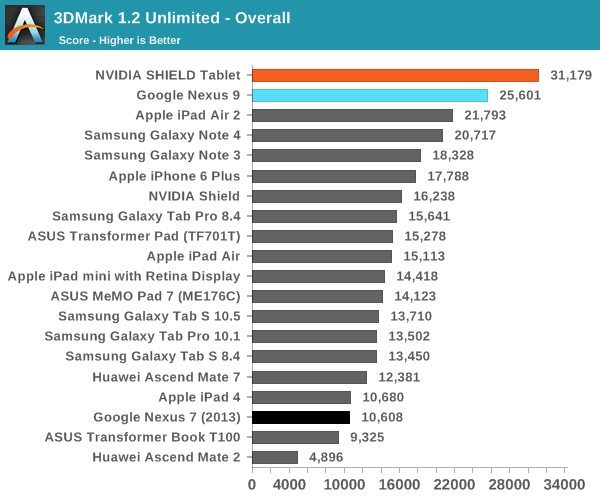
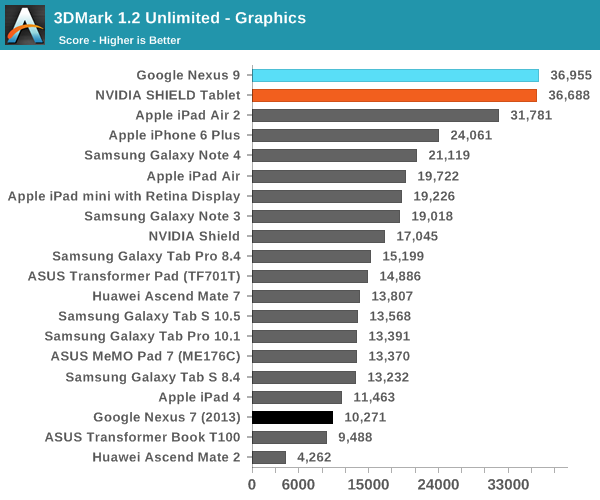
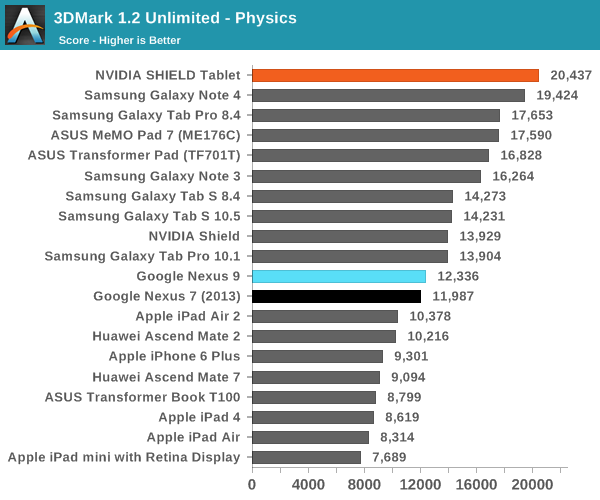
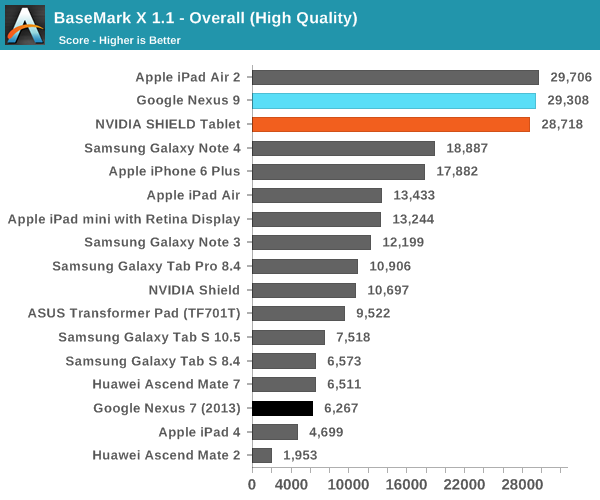
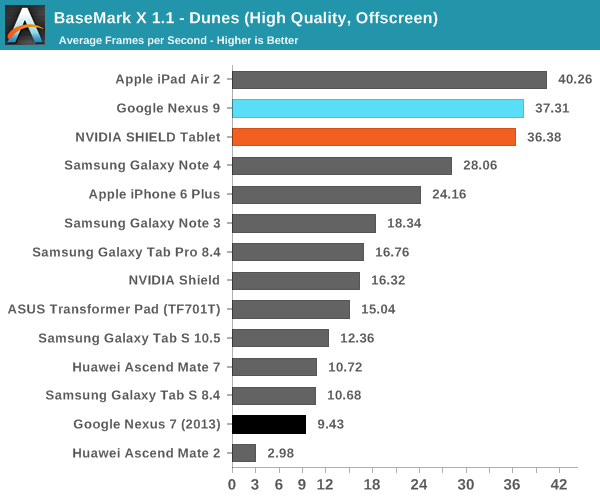
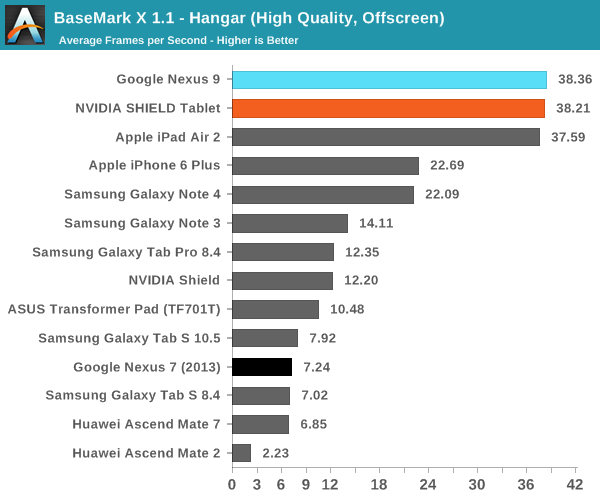
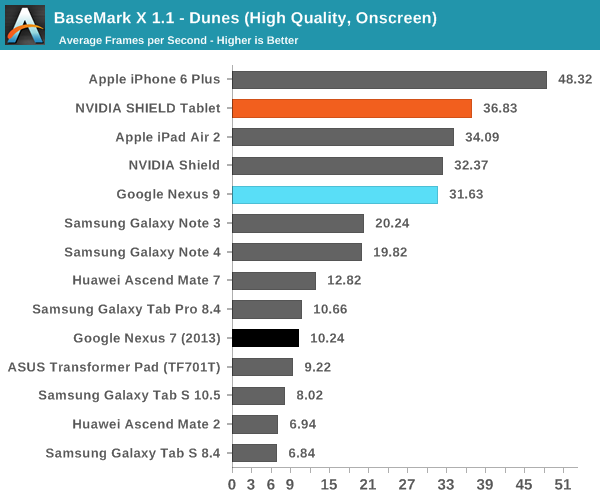
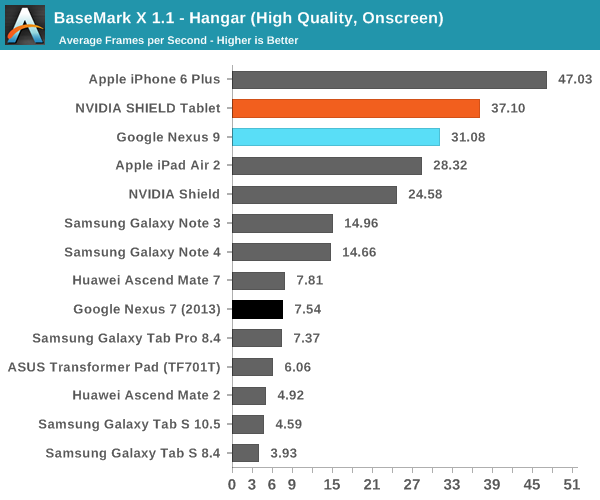
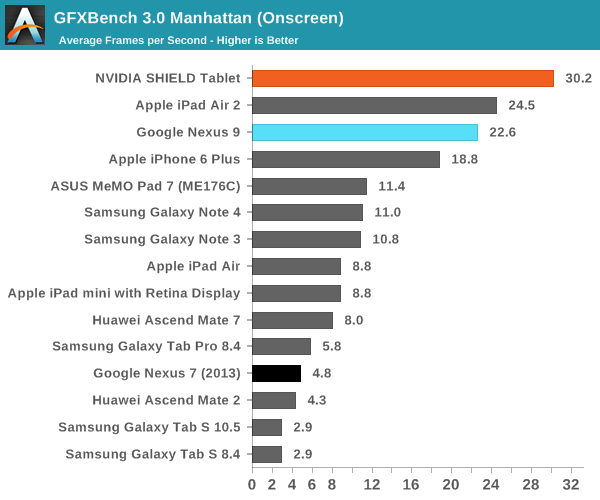
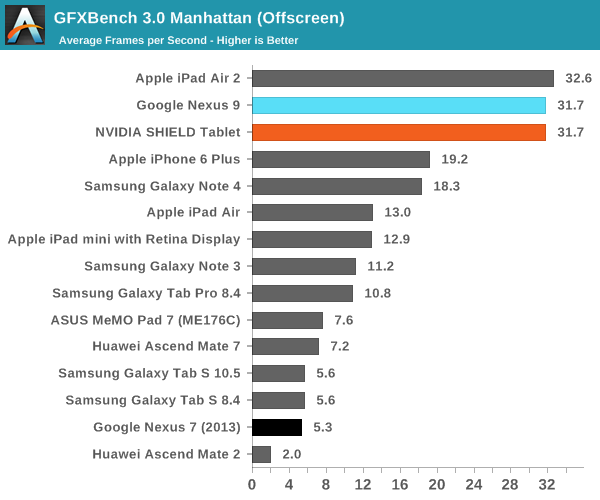
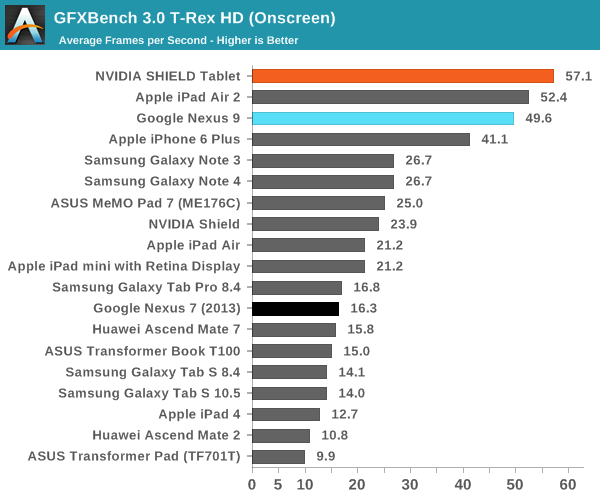
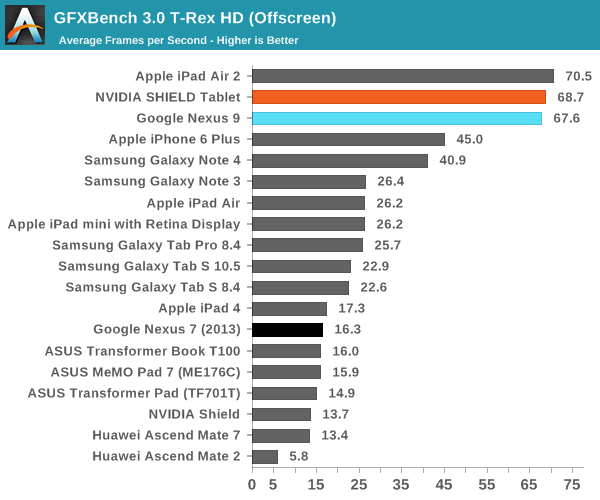
The Nexus 9's GPU has effectively identical performance to what we saw in the SHIELD Tablet, which means that the Nexus 9 should be able to support a broad range of games without performance issues. There is a bit of a noticeable performance delta when comparing on-screen performance, but this is simply due to the higher resolution of the Nexus 9's display. The one notable exception is the 3DMark physics test, which seems to scale with core count quite well, and that causes Denver to fall slightly short of the quad A15 configuration.
NAND Performance
While storage performance can often be secondary to a smooth user experience, poor storage performance is extremely painful. This is similar to RAM, where the difference between 2 and 3 GB is generally academic, while the difference between 512MB and 1 GB is enormous. While there have been some issues with Androbench with the move to Android 5.0, it seems that the timer issues have since been resolved, so it's possible to resume using the results from Androbench to get a rough idea of NAND performance.
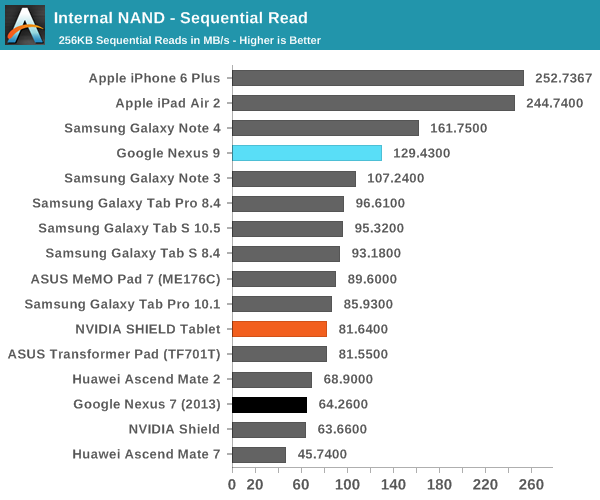
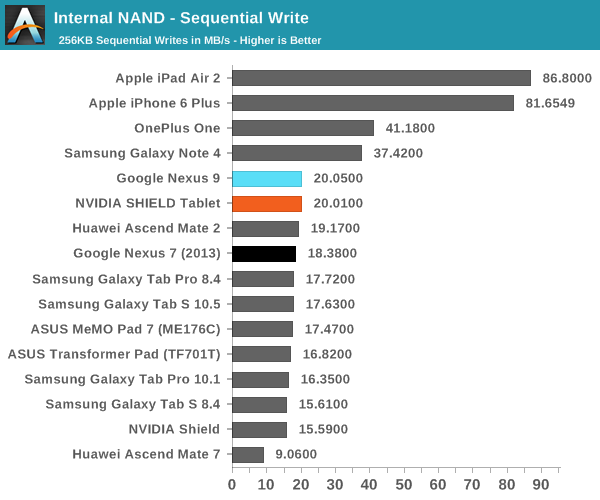
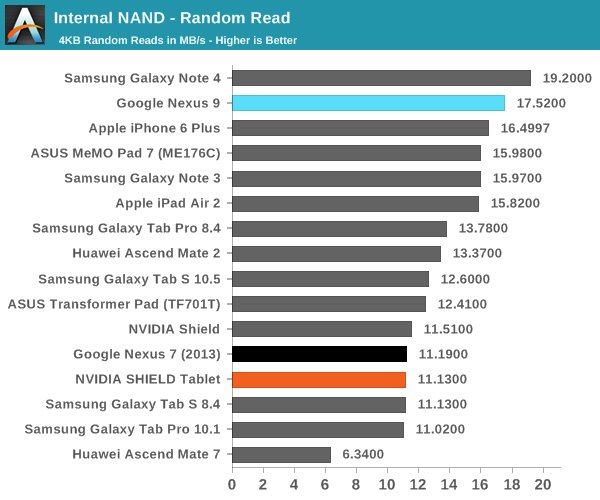
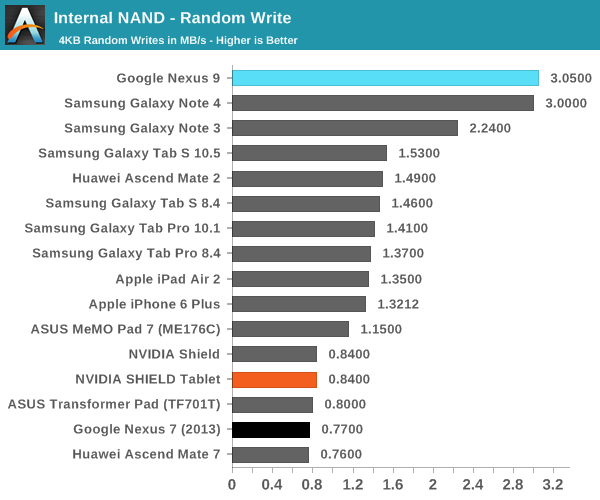
Here the Nexus 9 doesn't suffer nearly as much from full disk encryption that is forcibly enabled on the device; performance is noticeably higher than what we see in the Nexus 6. This seems to lend some credence to the theory that CPUs with ARM v8 ISA would be better suited to handling the need to encrypt and decrypt storage in real time. I tested the Nexus 9 with a custom kernel without full disk encryption to see how Androbench scores might change, but this didn't have a noticeable impact which seems to back this theory, although I'm still not confident that FDE is a good idea to enforce across all new devices.
The NAND itself, a Samsung eMMC package designated by the name BWBC3R, seems to be quite performant outside of pure sequential access, which seems to suggest that HTC hasn't skimped out in this area at all, and the use of F2FS is responsible for some of the best random I/O scores in any mobile devices we've tested thus far.










169 Comments
View All Comments
cjs150 - Wednesday, February 4, 2015 - link
No microSD - no chance of me buying it.Tablets are designed to be portable so why do designers never consider the needs of people on the move who may not have access to the cloud (either at all or at prohibitive cost). With 128 mb MicroSD card I can store tons of music, movies, tv shows and watch when I like on holiday
Impulses - Wednesday, February 4, 2015 - link
USB OTG ftwR. Hunt - Thursday, February 5, 2015 - link
Hardly the same thing though.UtilityMax - Sunday, February 8, 2015 - link
They want you to pay royalties to store your stuff in the cloud. I agree that 16GB is somewhat limiting. Half of that space will be used by the OS and applications, with barely anything left for user's data. I'd go with the 32GB model at the very least.NotLupus - Wednesday, February 4, 2015 - link
What's the date today?smayonak - Wednesday, February 4, 2015 - link
Ryan, I noticed that the Nexus 9 offers always-on (screen-off) Google Now activation. I checked in CPUSpy (and other apps) and noticed that even when all cores are parked, this feature works, suggesting that NVidia may have included a custom DSP or third core for audio processing. The +1 core in NVidia's Tegra platform was apparently transparent to the operating system, because it never showed up in CPU activity monitor apps.If it is a custom DSP used for natural language processing, this would probably run afoul of Qualcomm's lock on the IP. Which might explain why NVidia never announced a third core (or DSP) in the Denver platform.
I'm not sure if it's just my imagination at work -- can you confirm or disprove (or speculate) on the existence of a third core? Supposedly Android 5.0 includes support for idle-state audio processing, but only if supported by the hardware. But it would seem hardware support would require some kind of low-energy state processing core. And nothing of the sort appears in NVidia's press releases.
By the way, thank you for the amazingly detailed and insightful review. You guys are amazing.
Andrei Frumusanu - Wednesday, February 4, 2015 - link
Always-on voice activation is done by the audio SoC and has no connection to the main SoC or any DSP. Qualcomm's voice activation is done via the audio chip.smayonak - Wednesday, February 4, 2015 - link
Thanks. I have no doubt that's true, but I can't track down a reference. Anandtech's own article on the subject refers to Motorola's implementation of idle-state audio processing as relying on the X8's low-power cores, dedicated to handling audio processing.Motorola's press release claimed that their X8 included proprietary "natural language" and "contextual" processing cores (which I thought were some kind of analog-to-digital audio-processing DSP, but may be wrong), which allowed for always-on activation of Google Now.
I can count the number of devices that support screen-off Google Now on one hand. The relatively small number of devices with this feature is perplexing. Or maybe no one advertises it?
toyotabedzrock - Wednesday, February 4, 2015 - link
While turning a GPU into a CPU is a great accomplishment then essentially built a CPU that seems designed to benchmark well but will stall endlessly on real world code.Anonymous Blowhard - Wednesday, February 4, 2015 - link
This article is soooo late, clearly you should have just thrown up a half-page blurb with a clickbait title and was shallow enough that it could have just been written hands-off from the tech specs./s
Great read as always. Good things are worth waiting for.